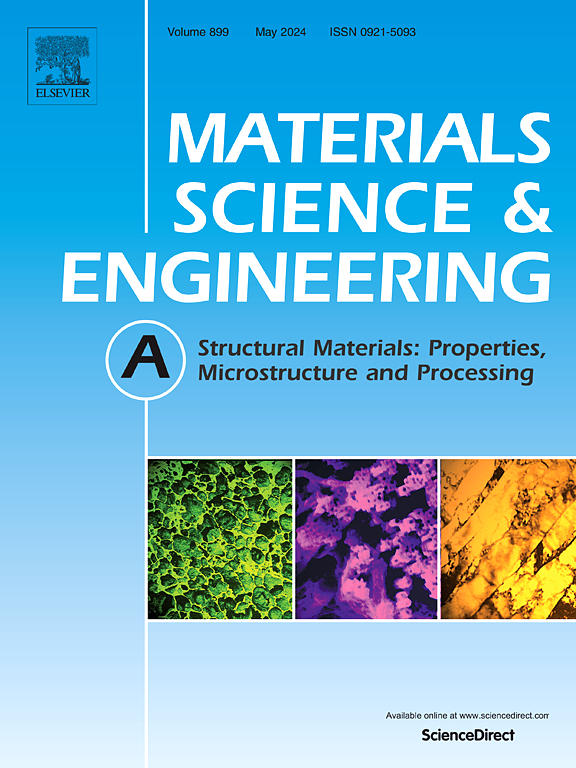Insights into strain delocalization and plasticity in pre-deformed metastable dual-phase medium-entropy alloys
IF 6.1
2区 材料科学
Q1 MATERIALS SCIENCE, MULTIDISCIPLINARY
引用次数: 0
Abstract
The interplay between strength and ductility in metallic materials has long been a paradox, particularly in microstructures laden with high-density dislocations where catastrophic plastic instability often undermines their mechanical potential. In this study, we unveil the origin of deformation mechanism that transforms this limitation into an advantage, enabling exceptional uniform elongation (∼45%) in hot-rolled metastable medium-entropy alloys (MEAs) under cryogenic conditions. By leveraging the dynamic coupling of deformation-induced martensitic transformation (DIMT) and strain rate sensitivity (SRS), we reveal how strain localization evolves into global strain delocalization, fundamentally altering the plastic response of dual-phase MEAs. Our findings show that low SRS at the early stage of deformation initiates the strain localization, triggering localized DIMT. As tensile deformation progresses, DIMT amplifies SRS, redistributing strain and enhancing ductility while maintaining high strength. This interdependence between SRS and DIMT, validated through strain rate jump tests and microstructural analyses, sheds unprecedented light on mesoscale deformation phenomena. Unlike traditional studies focusing on recrystallized microstructures, this work pioneers the investigation of pre-deformed, hot-rolled MEAs, correlating strain-hardening behavior with microstructural evolution in a high-dislocation-density matrix. These insights not only elucidate the mechanisms underpinning strain delocalization but also offer a transformative pathway for designing advanced alloys capable of exceptional performance in extreme environments.
预变形亚稳双相中熵合金的应变离域和塑性研究
金属材料的强度和延性之间的相互作用长期以来一直是一个悖论,特别是在高密度位错的微结构中,灾难性的塑性不稳定性往往会破坏其机械潜力。在这项研究中,我们揭示了变形机制的起源,将这一限制转化为优势,在低温条件下实现热轧亚稳中熵合金(MEAs)的异常均匀伸长率(~ 45%)。通过利用变形诱导马氏体相变(DIMT)和应变速率敏感性(SRS)的动态耦合,揭示了应变局部化如何演变为全局应变非局部化,从而从根本上改变了双相mea的塑性响应。研究结果表明,变形初期的低SRS启动了应变局部化,引发了局部化的DIMT。随着拉伸变形的进行,DIMT放大了SRS,在保持高强度的同时,重新分配了应变,增强了延性。SRS和DIMT之间的这种相互依赖关系,通过应变速率跳跃试验和微观结构分析得到了验证,为中尺度变形现象提供了前所未有的线索。与关注再结晶组织的传统研究不同,这项工作开创性地研究了预变形、热轧mea,将应变硬化行为与高位错密度基体中的微观组织演变联系起来。这些见解不仅阐明了应变脱域的机制,而且为设计在极端环境中具有卓越性能的先进合金提供了一条变革性途径。
本文章由计算机程序翻译,如有差异,请以英文原文为准。
求助全文
约1分钟内获得全文
求助全文
来源期刊

Materials Science and Engineering: A
工程技术-材料科学:综合
CiteScore
11.50
自引率
15.60%
发文量
1811
审稿时长
31 days
期刊介绍:
Materials Science and Engineering A provides an international medium for the publication of theoretical and experimental studies related to the load-bearing capacity of materials as influenced by their basic properties, processing history, microstructure and operating environment. Appropriate submissions to Materials Science and Engineering A should include scientific and/or engineering factors which affect the microstructure - strength relationships of materials and report the changes to mechanical behavior.
 求助内容:
求助内容: 应助结果提醒方式:
应助结果提醒方式:


